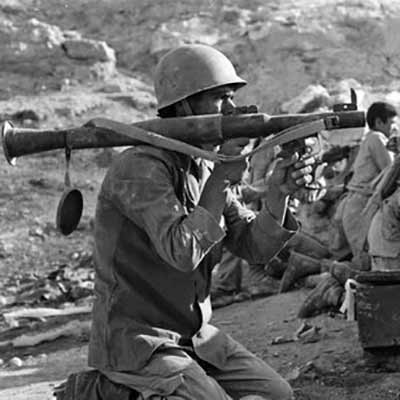Operation Fath-1
Zahra Ghasemi
248 بازدید
Operation Fath-1 was the first irregular operation conducted by the Islamic Republic of Iran in Iraq during the Iraq-imposed war. This operation was carried out in 1986, jointly by the Ramadan Base and the Patriotic Union of Iraqi Kurdistan, in the Kirkuk Province.
At the end of 1985, the Ramadan Base was obliged to increase cooperation with the Democratic Party of Iraq and start a new relationship[1] with Jalal Talabani, the leader of the Patriotic Union of Iraqi Kurdistan. This was needed in order to open up new a front in the Kurdish regions of northern Iraq. Following this decision and the actions that were taken, a series of conquest operations were designed. The first irregular operation was carried out 150 kilometers into Iraqi. It was called Fath-1. Its aim was to attack the Kirkuk oil facilities and military bases, spy, and disrupt the export of Iraqi oil.
Operation Fath-1 was a show of confidence by the officials of the Islamic Republic of Iran in Jalal Talabani and his group, thus establishing a relationship with them and implementing joint activities.
After the notification of the operation order to the Ramadan Base, who were to establish a sub-base of Ramadan in the Yaghsmar area of Sulaymaniyah, Iraq under the title of the Moghadam Ramadan Base, the command and deputy support of the Ramadan Base were obliged to bring the required weapons, ammunition, and war tools into the operational area. Military equipment was transferred to Iraq based on an agreement between Jalal Talabani, the leaders of the Patriotic Union of Iraqi Kurdistan and the commander of the Ramadan Base.
The operating forces included two battalions of the Special Guards Forces, one battalion of IRGC equipment, and two battalions of the Patriotic Union of Iraqi Kurdistan forces, who were deployed in the operational area after passing through Sulaymaniyah. In this operation, for the first time, a narrator was sent along with the operational forces.[2] Three brigades of Iraq's 8th Army were facing Iran’s operating forces.[3]
The operation started on October 10, 1986 at 01:30 with the codename “Ya Zainab” and with the firing of 120-mm mortars, 106-mm guns, and mini-Katyushas on the first axis, Jabalbar, and Jambur. Hours later, the operation began in the second axis, Saqzali and Daraman. In the third axis, the Demlan Mineral Heights, with a little delay, fighting and firing started on the Babagargar oil facilities. After these attacks and a massive fire, thick smoke surrounded the area. Iraqi forces started shooting with defensive weapons, presuming an air attack. Two Iraqi planes also came to the area, one of which was destroyed by a mini-Katyusha rocket. Helicopters also attacked several positions with rockets, and at least three of them were destroyed.
In this operation, the Kirkuk Refinery, which supplied fuel to the northern provinces of Iraq and exported oil to European countries through Turkish oil pipes, was destroyed. Also, the oil and gas facilities in Shurava, operating unit no. 1 of oil facilities, Kirkuk Electric Thermal Power Plant, which supplied electricity to the industrial areas and the city of Kirkuk, three surface-to-air missile bases, the headquarters of counter-revolutionary forces and MKO, oil facilities and Jambur gas, preliminary gas purification facilities, Jabalbar oil and gas separation facilities, Daraman barracks, Domlan heights bases, Iraqi electronic eavesdropping and jamming center in Saqzali, Iraqi Security Organization television station and Kirkuk antenna and television tower, and Baykore Railway Station, which was in charge of transporting oil and fuel products, were all destroyed. With the attack and firing on the camp of the 8th Iraqi Army and the camp of the 1st Iraqi Army, heavy damage was done to them, with a few Iraqi commanders being killed and injured. Kirkuk airport was also closed.[4]
The operation continued until 04:00. After that, the Iranian troops crossed the Sulaymaniyah-Kirkuk Road and moved towards Aman Village.[5] In the Iraqi regime's military announcement No. 2396, which was published on the day of the operation, there was no mention of this operation.
The day after the operation, at 13:10, Iraqi planes bombarded the village of Surgashan.[6] On the same day, Latif Jassim, the Minister of Information of Iraq, announced that the Kurds of the Iraqi opposition have operated jointly with Iranian forces.[7]
In 1991, the Operation Kirkuk movie was written and directed by Jamal Shoorje. It was based on Operation Fath-1.[8]
[1] After the victory of the Islamic Revolution, the Kurdistan Democratic Party of Iraq, led by Masoud Barzani, established good relations with Iran. In the meantime, the Patriotic Union of Iraqi Kurdistan, led by Jalal Talabani, took a dual approach with the Islamic Republic of Iran. Despite welcoming the formation of a new government in Iran, he was active in front of the opposition of the Islamic Republic of Iran and helped the rebels who were creating disaster in the Kurdish regions of Iran. From 1985 onwards, the IRGC was able to carry out cross-border operations in the Kurdistan region of Iraq with the establishment of the Ramadan camp under the command of Mohammad Baqer Zulqader. (Sadeghi, Reza, Guide Atlas 12: West Azerbaijan in the war with counter-revolution and holy defense, Tehran: Center for Documents and Research of Sacred Defense, 2012, p. 196.)
[2] Sadeghi, R., Guide Atlas 12, p. 198; Negin Iran Quarterly, Holy Defense Documents, and Research Center, Year 11, No. 40, 2013, pp. 102, 108, 109.
[3] Guide to 8-year war operations, Tehran: Center for War Studies and Research, 1990, p.67.
[4] Journal of the Islamic Republic, No. 2136, 10 October 1986, p. 2.
[5] Ansari, M., Fawzi, Y., & Lotfollahzadegan, A., Journal of the Iran-Iraq War, Book 44: MacFarlane's Story, Tehran: Revolutionary Guard War Studies and Research Center, 2001, p. 304.
[6] Ibid, p. 306.
[7] Ibid, p. 314.
[8] Omid, J., Culture of Iranian Cinema Films, Volume 3, Tehran: Negah, Ch 3, 2001, p. 891.



